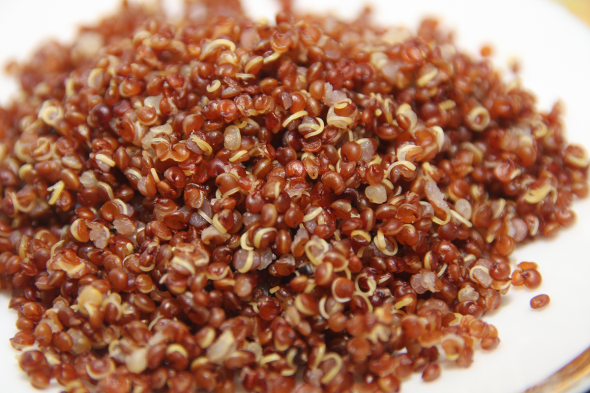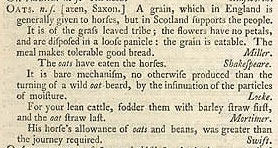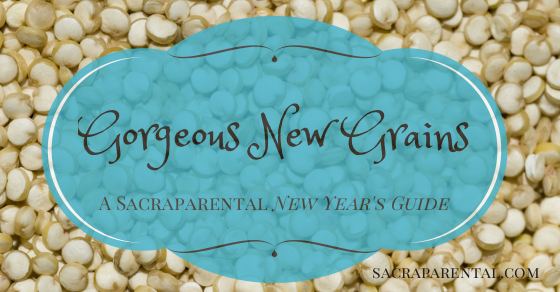New Year’s Guide to Gorgeous New Grains
223 January 2014 by thaliakr
toast
Weetbix
spaghetti
biscuits
sandwiches
muffins
pizza
couscous
pancakes
scones
fritters
cake
crackers
noodles
pita pockets
crumpets
Are any of these on your regular playlist? (And am I making you hungry?)
It seems like quite a variety of starches for your diet, but look again: every single one is (usually) made out of wheat.
People who adopt a gluten-free diet quickly realise how pervasive wheat flour is. Not only bread, cakes, biscuits and crackers, but pasta (and couscous is just a tiny kind of pasta) and heaps of breakfast cereals are all just wheat, processed into different forms.
Nacho chips, tortillas, polenta, corn crackers: all corn. Rice, rice noodles, rice crackers: you get the idea. Go to most cafes or restaurants and all the grains on the entire menu are varieties of wheat, corn or rice.
I like general principles, rather than rules, for guiding what I eat, and what I feed my household. Michael Pollan has a great seven-word philosophy, for example:
Eat food. Not too much. Mostly plants.
One principle I’ve had in mind recently is this: eat a variety of species. Just eating versions of wheat, rice and corn all day every day seems a bit limited.
I’ve got pretty lazy about this over the last year. Managing to cook at all has been enough of an achievement! So we’ve eaten a lot of rice.
As the new year rolls around – and more significantly for my headspace, as I’ve had a fortnight off cooking while away on holiday – I’m feeling ready to re-expand my list of ingredients. I thought I’d list some of the grains and starches I want to incorporate or get back into, as part of motivating me and maybe you.
What works best for me is to incorporate one new ingredient at a time into regular cooking. Once I’m confident with how to use it, and it’s in regular use, I can move onto something else.
For example, 2010 was the year I started cooking tofu regularly. It took a week of concentration and new recipes (kindly put together by Jody and Julian in my own ‘Some of Us Like Tofu!’ cookbook). Then I tackled aubergines, and after a couple of weeks I had half a dozen new weeknight-dinner-type meals in rotation.
In the same way I went from zero to hero in the world of cooking with legumes (adzuki beans and black-eyed beans are definitely worth your while), and from basic to brilliant in the land of smoothies (which deserve their own blog post, don’t you agree? [Update: done!])
Do you have a practice or system (conscious or otherwise) of expanding your recipe and ingredient repertoire? I’m keen to hear what works for you, so please leave a comment with your ideas.
And what grains are regulars in your diet apart from wheat, corn and rice? If you have favourite recipes or flavour combinations to inspire us, please share them! I’m a complete amateur with this stuff, so if you can add info or wisdom, I’m very keen for you to do so.
Over the last year or so, the only grains I’ve regularly cooked with are:
brown rice
red rice (Thai)
black rice (Italian)
arborio rice (for risotto)
oats (a mix of wholegrain and rolled)
wheat (flour)
barley (in soups)
Other grains I have cooked with in the past but have got out of the habit of using include:
quinoa (red, white and black varieties), which I used to use a couple of times a week and will again very soon
buckwheat
amaranth (didn’t find it very appealing but need to try some different ways of using it)
The ones I want to get to grips with this year are:
teff
millet
sorghum (which only got on my list because I read about it while writing this post – thanks, blog!
So for the New Year’s Guide, I’ll rave on a bit about the ones I know well: quinoa, barley and oats. The rest will follow, though perhaps not early enough to qualify for this series – and I’ll need your help for them!
Quinoa
Quinoa is a gateway grain. It’s easy to cook and readily available these days, so it’s a great one to start with.
It’s also a superfood! It has an enormously high protein content, so it’s great for meals or diets without meat. It is a good source of lysine, magnesium, calcium, iron and a bunch of other things.
It comes in different colours, so can be nice and dramatic on the plate.
Apparently it’s a ‘pseudocereal‘ but I’m not going to be botanically fussy about such things. If you can serve something in place of rice or wheat or corn, I’m including it here!
It comes from South America, and the name, from Quechua, is usually pronounced keen-wah by English speakers.

Cooked red quinoa, image via Wikipedia.
Cook it just like white rice. Give it a rinse first in a fine sieve (the uncooked seeds are tiny), or it goes a bit soapy. Use a 1:1 ratio of water to quinoa, and cook for 10-15 minutes, until the outer ring of the quinoa starts to detach. I usually microwave it for 12 minutes.
Use it just like rice or couscous – under a curry or casserole, or tossed in a salad. For more ideas, see grain guru Heidi’s fabulous collection.
Here’s my special occasion quinoa dish – I often make it for Christmas Day. For all these recipes, I can’t say I really measure things, so do take the amounts as loosely indicative rather than the gospel truth.
Decadent Quinoa for a Crowd
Ingredients
- Lots of roast veges, however you like to do them
- 1/3C dried quinoa per person, washed in a sieve
- 1 avocado, chopped
- 1-2 red, orange or yellow peppers/capsicums, finely chopped
- 1C sundried tomatoes, chopped
- 1C dried fruit (dates, apricots, cranberries, whatever you like), chopped
- 1C toasted or raw hazelnuts, chopped
- ½C sunflower or other seeds
- zest and juice of a lemon or orange
- an orange, peeled and chopped
- anything else you feel like
Method
- Chop and roast the veges
- Chop everything else
- While the veges are roasting, cook the quinoa however you like cooking rice (I put it in the microwave for 12 minutes; it’s cooked when the outer ring separates from the globe of each grain).
- When the veges and quinoa are both ready, toss everything together and serve immediately (just so the avocado doesn’t get cooked!)
Quinoa is pretty cheap, especially if you get it from the bulk bins, and super-easy to use. Go on, put it on your shopping list for this week!
Barley
I add barley to soups and otherwise pretty much use it only in the recipe below, adapted from Lois, who adapted it from Alison Holst.
I’ve come to call it ‘barley risotto’ but it’s easier than a rice risotto cos you don’t have to stir it constantly.
Barley is a nutritious wholegrain (though pearl barley has some of the bran removed) which contains gluten.
Barley Risotto
Ingredients
- 2-3 onions, diced
- 2 T minced garlic
- 2 T minced ginger
- Lots of whatever root veges you like (or mushrooms if you’re Lois), diced
- 1-2 C barley
- 1-4 C vegetable stock or other liquid to cover all ingredients
- 1 C sundried tomatoes, chopped
- Lots of green veges, chopped
- 1-2 C cooked chickpeas (or any other bean or lentil)
- Juice and zest of a lemon
- Spices (I usually do 1 T cumin, 1 T ground coriander, 1 t chilli)
- Optional 2 T soy sauce
Method
- Sauté onions, garlic and ginger
- Add chopped root veges (I alternate pumpkin and kumara, sometimes carrot as well) and/or mushrooms
- Add a cup or two of barley and vege stock or water to cover
- Optionally add some soy sauce, but I ran out a while ago and haven’t used it lately.
- Cover and cook for something like 45 minutes, just check every so often that nothing’s sticking.
- Add chopped sundried tomatoes and green veges – silverbeet, broccoli, whatever, cook till nearly done.
- Add chickpeas or lentils (here if canned, at the beginning if needing to be cooked).
- Add lemon zest and/or cumin and chilli or whatever flavour you feel like.
Oats

The entry for oats in Samuel Johnson’s Dictionary, via the British Library.
Oats are officially amazing. Don’t listen to Dr Johnson: they’re not just for horses and the Scottish.
Oats are a good source of soluble fibre, which probably makes them particularly good for your heart. They’re wholegrains, no matter how finely chopped or rolled they are, with minimal processing, so you get all the goodness the plant provides.
They’re gluten-free in themselves, but often contaminated by wheat in growing or processing, so people with coeliac disease may need to be a bit careful about sourcing gluten-free oats.
It’s not hard to get a serving of oats each day. If you swap toast for porridge, or a processed breakfast cereal for an oat-based muesli, you’ve just expanded your grain repertoire and added a delicious treat to your morning. I was struck by how much later I felt like lunch when I started eating muesli or porridge for breakfast instead of toast.
I substitute oats for at least half the flour in recipes for things like vegetable fritters and fruit crumble toppings. You can blitz the oats in a food processor to make a finer flour-like powder if that helps in a particular recipe.
Rhubarb and Raspberry Crumble
Ingredients
Filling:
- 2 C chopped rhubarb
- ½ C brown sugar or other sweetener
- 2 C frozen or fresh raspberries
- juice and zest of a lemon
- 1 t cinnamon
Crumble:
- 1 C rolled oats or oat-based muesli/granola
- ½ C wholemeal flour
- 1/3 C brown sugar or other sweetener
- ½ C Olivani or other dairy-free spread (a couple of big scoops with a spoon) – or butter, of course, if you eat dairy
- 1 t cinnamon
- 1 t mixed spice
- ½ C mixed seeds and mixed chopped nuts if they’re not in the muesli already.
Method
- Stir rhubarb and first measure of sugar over a low heat until the sugar caramelises and thickens (so you can see the bottom of the saucepan when you scrape along it with a wooden spoon)
- Add lemon juice, zest and cinnamon and mix in
- Add berries
- Tip into baking dish
- Mix all crumble ingredients in a food processor or by hand.
- Pour crumble topping over rhubarb mixture and pat down evenly.
- Bake at 180C for 25-40 minutes, or until topping is brown and fruit is bubbling.
If you ask him nicely, Julian might add his ‘porridge pancake’ recipe in the comments. It was developed when one of his sons stopped liking porridge, and goodness me, they’re delicious.
I put oats in smoothies, too, to add some carbohydrates and make them more of a meal. But that’s a story for another post.
Right, that’s definitely enough for one post. I’m very keen to hear from you, now!
How do you keep your cooking repertoire fresh, especially if you’re the primary household caterer? What do you do with grains? Any recipes or links to share?
Thanks in advance for all your help, and for the motivation inherent in writing this kind of post. I’m inspired to go to Moshim’s tomorrow to stock up on bulk grains.
This is part of an annual series of New Year’s Guides. If you’d like to suggest a topic or offer to write a guest post on pretty much anything, please leave a comment or get in touch privately.
Category: food, home | Tags: 101 Cookbooks, amaranth, barley, buckwheat, corn, domestic genius, grains, millet, New Year's Guide, oats, quinoa, recipes, rice, risotto, sorghum, teff, wheat, wholegrains


Wow this is amazing! You are definitely my hero when it comes to all this stuff. Expanding our grain repertoire is something that has been in the back of my mind for a while. You will remember I got some quinoa to try, but I tried it for breakfast cereal first, and would have been better off trying something like your amazing sounding Decadent Quinoa. Thanks for the motivation!
I’m also keen to learn more about flours/flour substitutes for baking. My biggest food blog hero does some great stuff, and I have been very quietly thinking about working out where to get started. How’s that for commitment?! I totally agree with you – I seem to only be able to manage one significant change at a time. Feel free to do the hard work for me :)
(Here’s an example from La Tartine Gourmande:
http://www.latartinegourmande.com/2012/05/17/gluten-free-marbled-cake-recipe-nutritious/ )
Thank you for all the legumes you have got in to my children over the last couple of years, and I was delighted at how Reuben gobbled up your wild rice. You are helping us to make some changes for the good! x
Oh, thanks, Angela! Such kind words. I will feed your family any day of the week :) And eat at your house when you next have one!
I don’t bake enough to have much to say about flours, but along with your link, Heidi at 101 Cookbooks does heaps of that. I can’t find my cookbook of hers – there really must be one mysterious box hiding, un-unpacked somewhere! – but check out her baking category for ideas if you need any further inspiration… http://101cookbooks.com/baked_goods/
My next step (it was going to be today till I got sick) is to set aside a morning to plan a menu and go to Moshim’s or Bin Inn for everything. I find once I’m at that kind of place I get inspired to get a bunch of interesting things and use them, as long as I’ve got space in the following days to follow through.
Maybe we can have a field trip together! Anyone else in Welli keen? :)
Yes! Um… are there still Bin Inns in Welly? I didn’t realise.
I can’t foresee any problems with you, me and three small children in a bulk bin shop.
Ha!
Petone. Also Moshim’s in Newtown (Asian foodstore) though I haven’t made it there yet. Petone is good, but, well, in Petone, and I haven’t made it there since we got back.
Petone is close to Avalon. You would need to come visit afterwards.
Ha! You don’t want to join us so we have four pre-schoolers in a bulk bin shop!?
I’ve taken Lachie to BinInn before. Once is enough.
Gorgeous cake recipe!
I can’t remember where I read it, but oats are meant to be good for increasing your milk supply when breast feeding too. Or at least that’s the excuse I gave myself for eating copious amounts of flapjack when Tobes was tiny.
Ha! Yes!
I have never been able to track down any proper studies on this stuff, but it’s certainly a consensus in the lactation support world. Oats and brewer’s yeast were the things I settled on when I was researching and making ‘lactation cookies’ (they DO NOT contain breastmilk!). That’s another post, too…
Ok, update on the science. Jury’s out, but this is a great summary of the research: http://kellymom.com/bf/got-milk/supply-worries/oatmeal/
Buckwheat pancakes are a great way to use buckwheat flour. They are delicious! I make this recipe a lot – using rice milk and oil instead of the cow milk and butter.
http://mattikaarts.com/blog/baking-recipes/gluten-free-buckwheat-pancakes/
I’ve read about teff, but never found it in NZ. I’d be interested to know if you do. I’d love to make injera. http://chefinyou.com/2010/02/ethiopian-injera-recipe/
Thanks for the recipe!
Ok, will keep you posted on teff. Hadn’t realised it might be scarce – I’d like to make injera too! But I’ve definitely *eaten* injera in NZ, so that’s hopeful!
I’ve heard that most people make it with wheat here, so that’s not hopeful. Commonsense apparently has it, but I’ve never seen it there.
I couldn’t find teff flour when I wanted to make (a cheat’s version of) injera crepes fairly recently. The recipe said you could sub buckwheat flour for teff flour… they were disappointing AND dinner culminated in my son choking on pear and spending the night in hospital.
That’s a TERRIBLE evening :(
I am very bad at this sort of stuff. We eat an awful lot of pasta, some rice and a bit of couscous. I’ve never come across red rice, and have never even heard of some of the items on your list (teff, for example – no idea what injera is either…) But, inspired by you, I have just sprinkled oats onto today’s loaf of bread before baking, so that’s a start at least, right?!
Actually, Alex, you are Brilliant and Amazing. I have proof.
And yes, oats on the bread is a great start! Well done!
[…] on from our Guide to Gorgeous New Grains, here are some ideas for incorporating more legumes into our weekly […]
Hey! Here is the link to “porridge pancakes”: http://ciaofromdebbie.com/recipes/vegan-oatmeal-pancakes/ We put the dry ingredients in the blender to get the oats fine. (I’m sure I don’t need to point out that as Ideas Woman, I was the person who sourced and first made these when our young man gave up on porridge… but jw was the person who took it and ran with it!)